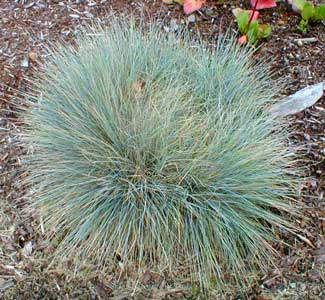
Elijah's Blue Fescue
or Sheep Fescue
"The grass & trees are my speech."
-George T. Delacourte
(1894‚1991)
(1894‚1991)
Festuca ovina var glauca 'Elijah Blue' is said to be the bluest of the blue fescues. It is named for the prophet Elijah the Tishbite, whose bed by the brook Cherith was only grass, & who in that time of drought in Israel defeated the priests of Baal thus restoring the rainfall & the grasses for the horses & livestock.
'Elijah Blue' is a clump-forming silvery-blue ornamental grass that holds its powder-blue foliage color throughout summer, being drought & heat tolerant in our region (Zone 8), where it is evergreen. In colder zones, down to Zone 4, it's not evergreen through winter but otherwise still an easy thing to grow.
In western Washington gardens, when other ornamental grasses have dried out in autumn, Blue Fescue trundles along looking pretty good through most of the winter. It does get pretty scruffy by winter's end however, so always needs shaving down to start fresh in late winter/early spring.
Blue fescue is native to Europe. It is frequently listed as F. cinerea but this is incorrect; F. cinerea is a look-alike species. 'Elijah Blue' is apparently a catch-all cultivar name for several strains & not all are of equally blue intensity; if selected on the basis of new spring growth the color merits can be assessed.
The clump will be ten inches or a foot wide, & does not continuously widen, keeping itself as a tidy mound. It stands four to ten inches tall; when in bloom the straw-colored stalks add another ten inches of sprays.
It blooms in late June or in July & produces viable grass seed, & it will spread. It can be rather weedy. The blooms are of only moderate ornamental interest. Before they mature into tan seeds they should be removed or it will self-seed where not wanted. When it is in full bloom it can be given an early summer sheering to get rid of all the seedheads & smooth out the clump; if permitted to go to seed, the clump may not look quite so vibrant the rest of the year.
It likes full sun best. Although it does adjust to bright shade or partial shade, it will not develop such blue foliage without lots & lots of sun. It needs well draining sandy soil, will do poorly if too often wet, & cannot stand humid hot climates. It is well liked by visiting deer & rabbits, but it grows back readily, & it just might keep the beasties from nibbling something more significant. It tolerates salt-spray maritime climates, suitable for seaside gardening.
There are many clumps of blue fescue on an estate for which I do some landscaping near Hood Canal. Over time I'm replacing the grass clumps with little shrubs or flowering perennials. I'm just not a fan of ornamental grasses, & were I to make a few exceptions, it would be for oat grasses with their wonderful seedheads, or zebra grass for the odd stripes, but blue fescue, not my choice, & I convinced the owners of the estate to let me swap them out for more interesting things.
So this would not have been planted if I'd been on staff when the original choices were made. I believe they were selected for drought hardiness, as they were mixed in with lavenders & groundcover junipers & similar low-maintenance plants. But there are so many clumping drought-hardy choices that also have great flowers or even some low-growing shrubs with berries.
But to give it its due, blue fescue can in its prime & at its best look extremely nice against a grey stone wall or in rock garden. Since taste is subjective & personal, many people do seriously enjoy ornamental grasses, & blue fescue is one of the bestsellers.
Shortlived in the garden, it is sometimes at its peak of good looks no longer than two years, & will more certainly be beyond its prime in three years. The clump shown above in late May is beyond its prime.
It doesn't actually die out but wears out, as only young clumps are particuarly handsome. As it ages the tussocks or mounds hump up too much in the middle, then begin to die at the center.
When it stops looking its best it should be dug up either spring or autumn, the thick center cut out of it & sent to the compost, & the best sections divided in order to start new clumps. To refresh it without having to wait for it to regrow into a new clump, it can be "cored" & the center of the clump discarded, then the center can be "plugged" with a young plant. Or if you're like me, you may decide that worn-out clumps can just be replaced with dwarf evergreen azaleas or some similar plant with greater interest.